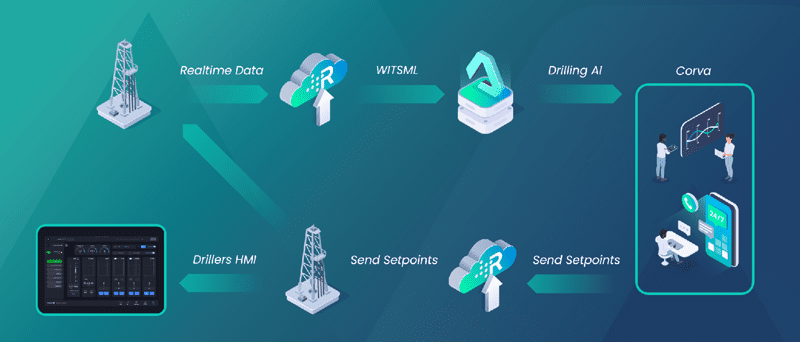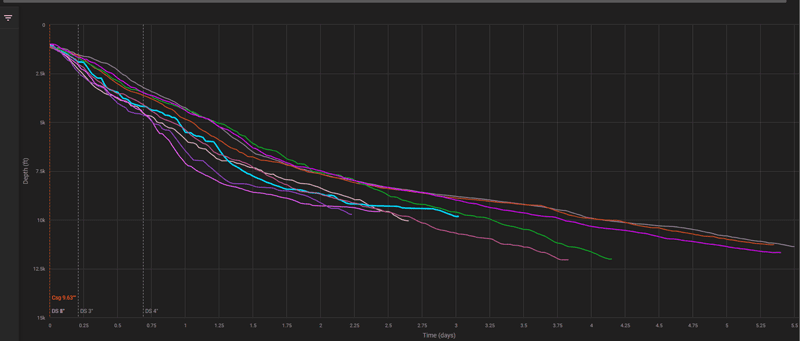From our smart connected homes and self-parking cars to generative AI apps like ChatGPT, automation and artificial intelligence have rapidly become a part of our lives, and the oilfield is no exception. Historically slow to adopt the latest technology, the oil and gas industry is poised to take a rapid stride toward the prize of closed-loop, fully autonomous drilling automation. However, like any sudden innovation, AI managed drilling operations are the culmination and intersection of the right technologies, mindset and point in time.
Foundational Technologies
The road to automating drilling operations with AI is much like that of self-driving cars. For years, people had been surrounded with automated systems but always in the loop. Drivers receive turn by turn directions from their smartphones and are guided efficiently to their destination; however, the decision to follow driving recommendations was always up to the driver. Similarly, drillers have benefited from automated offset well analysis and AI-recommended drilling parameters, yet have remained in the loop making the final decision.
Today, fleets of self-driving cars are rolling out across several U.S. cities. To get to this point, Google Waymo and other services had to bring robotics and process control hardware together with real-time data and intelligent software, yet achieving safe and consistent transportation isn’t a matter of simply programming a vehicle to move from point A to point B.
Open-loop automation, such as running a sprinkler system or dishwasher, does not collect feedback or analyze operations to adjust output and is therefore not suited for the complexities of navigating a car or drilling a well. Programming automated pipe management and bottom hole assemblies to navigate from point A to point B along the well trajectory will always encounter the unexpected and fail without feedback on actual drilling conditions like torque and vibration. What is needed is closed-loop automation, smart technology that adapts on the fly based on feedback and, just like the success of self-driving cars, confidence in the technology from the end user.
Fleets of closed-loop auto-drillers fully managed by AI are now appearing in the oilfield with the combination of two technologies centered around real-time rig data and the cloud. A pioneer in automating drilling operations, Nabors introduced SmartROS®, a universal drilling rig controls and automation system. SmartROS enables drilling contractors to deploy advanced machine and process automation, including with top drives, draw works, pipe handlers, rotary tables and mud pumps, scalable fleetwide, regardless of rig and equipment manufacturer. By automating rig control and movement, the Nabors system alone can increase drilling consistency and efficiency (e.g., decreasing pipe connection times by more than 50 percent).
Adding another level of drilling optimization that can dramatically improve rate of penetration (ROP) and eliminate days of costly rig time, Corva enables drilling contractors and operators to consume real-time rig data via Wellsite Information Transfer Markup Language (WITSML). Corva’s suite of predictive analytics processes WITSML and other well data to analyze drilling parameters, such as RPM, differential pressure, torque, weight-on-bit, and mechanical specific energy, in order to identify optimal set points.
Early adopters who have already profoundly optimized their drilling operations piecemeal with Corva and SmartROS can achieve as much as 45 percent more ROP improvement by bringing the two technologies together and feeding drilling set points into automated rig systems with AI in the loop.

Closed-Loop Drilling Automation
In 2018, Corva began training preliminary machine learning models, initially focused on optimizing on-bottom rotary drilling. Just as ChatGPT and other artificial intelligence models took years to come to fruition by training on big data, Corva’s Drilling AI developed over five years while analyzing terabytes of real-time and historical drilling data, culminating in its Predictive Drilling solution. The technology enables the driller or remote operations center to define an ROP objective with user-defined guardrails for minimum and maximum RPM, weight-on-bit, and differential pressure. The AI model then recommends optimal drilling set points to the driller in real time.
True, AI-managed, closed-loop auto-drilling is now possible by marrying Predictive Drilling with SmartROS rig automation. Leveraging Nabors’ process control system and high-quality data pipelines built on a redundant Starlink satellite connection, Corva gathers real-time WITSML, offset well, and vibration data from even the most remote locations. Data streams are processed through the cloud-based Predictive Drilling AI model, and optimal set points are fed back to rig-based SmartROS controllers, enabling the rig to self-adjust based on the last 250 feet drilled and re-fit to the AI model each stand of pipe, with drillers able to monitor rig operations from a tablet and human-machine interface (HMI) application.
By enabling closed-loop automation on the drilling rig powered by AI-optimized set points, the oilfield is entering a new era of digital transformation that will enable energy companies to further reduce the average cost per foot drilled, minimize dysfunction, and save time on tripping pipe. The joint technology venture from Corva and Nabors is currently deployed in the Permian’s Delaware Basin and the Three Forks Formation in the Williston Basin. As drillers gain confidence in closed-loop drilling automation, teams increasingly rely on the technology for most of the rotary drilling process, as much as 85 percent in current field testing with two supermajors.
- Results from Permian and Bakken wells include:
- 35 – 45 percent higher rotary ROP versus offset wells
- Up to 20 percent reduction in lateral and axial vibration
- Average lateral drilled in a single run saving one to 1.5 days on rig rental cost
- $100,000 – $150,000 saved in spread and bit costs per well
- Reduction in driller HMI interaction by 5,000+ per well

The Future of Drilling Automation
As with the introduction of any innovation, AI-managed drilling automation is starting with a narrow focus on the rig and will scale to include more drilling use cases. Unconventional onshore rotary drilling is a logical first step for closed-loop automation given that most on-bottom time is spent in the vertical and lateral sections. Directional drilling, or sliding, will require new solutions and AI models to better control toolface consistency, avoid bit divergence, prevent equipment wear, and minimize slide time. Extended reach and deepwater wells also introduce complexity and new opportunities for AI and drilling automation, where the Corva and Nabors closed-loop solution can eventually advance operational performance and well productivity.
Closed-loop drilling automation pays dividends in safety and cost reduction by reducing rig rental time and extending bit life. Automation is also about improving wellbore precision and drilling consistency across fleets that lead to better wells, turning a P50 well into a P75 well, and increasing the estimated ultimate recovery.
The massive efficiency and economic gains enabled by AI-powered drilling automation come at a time when the U.S. oil and gas industry is being asked to steadily increase energy output to meet global demand while maintaining capital discipline and returning more value to shareholders. The technology is ideally positioned to meet these goals head-on with existing resources. Indeed, as the world comes to terms with the potential of AI and automation to augment human performance without replacing people, drilling teams are embracing these innovations to minimize distraction, focus on non-repetitive workflows, and improve job satisfaction.
Headline photo: Nabors Rig, courtesy of Corva.
William Fox is the General Manager for Predictive Drilling at Corva, and has previously held both management and operational roles at Data Gumbo, MHWirth and NOV. His work has focused on drilling automation and supply chain digitization.
Tatiana Borges is Sr. Product Development Manager of Nabors Drilling Solutions (NDS). Borges manages the development of novel drilling automation and technology deployment efforts for NDS. Borges began her career as a field engineer for Schlumberger, working in different countries and product lines in engineering, operations and product management.
Oil and gas operations are commonly found in remote locations far from company headquarters. Now, it's possible to monitor pump operations, collate and analyze seismic data, and track employees around the world from almost anywhere. Whether employees are in the office or in the field, the internet and related applications enable a greater multidirectional flow of information – and control – than ever before.





